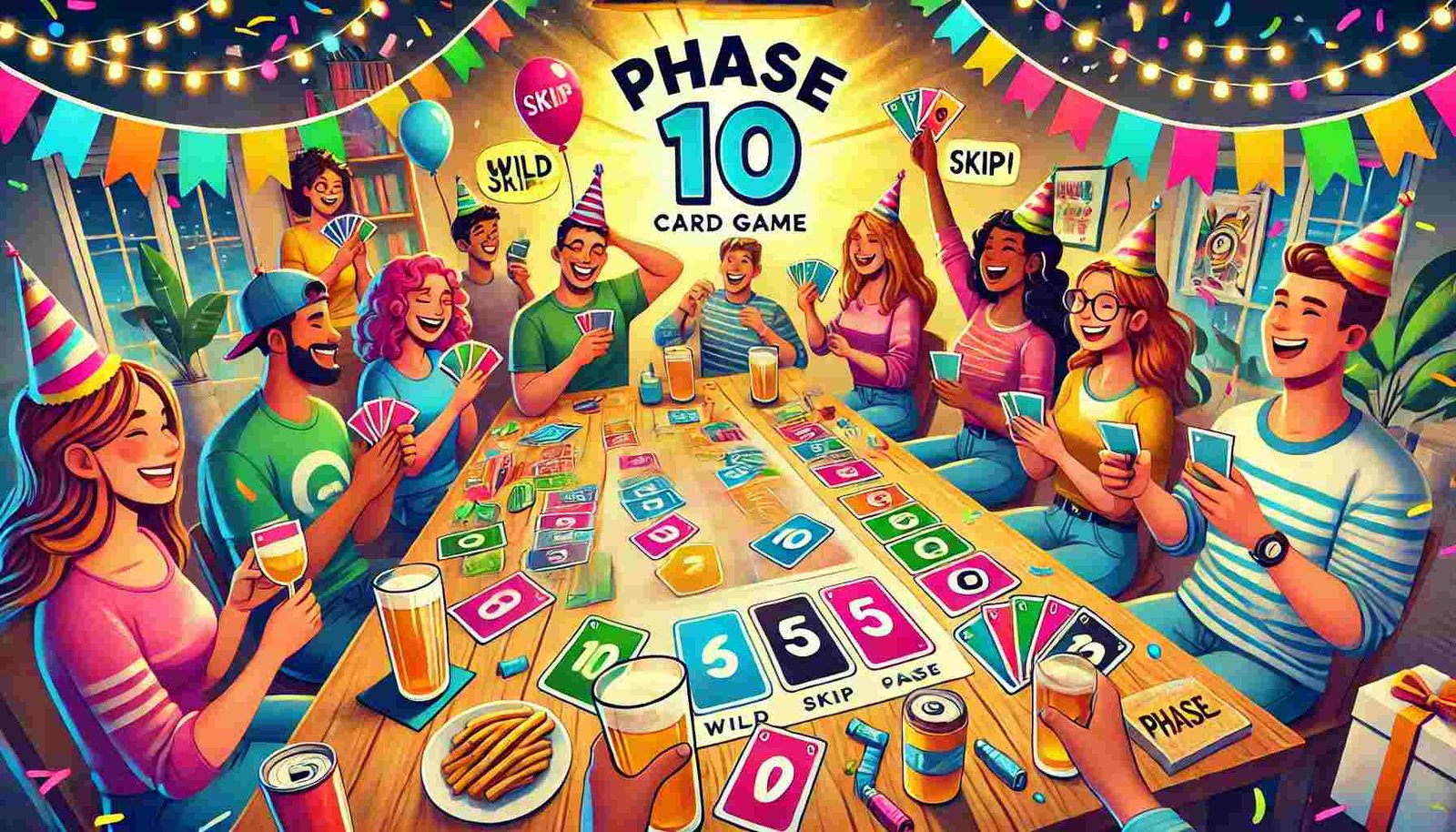Phase 10 is a card game that mixes strategy, luck, and a whole lot of fun, especially for fans of Rummy card games. Invented by the creators of UNO, this game challenges players to complete ten unique “phases” or sets of cards. Think you have what it takes to complete all ten and beat your friends to the finish line? Let’s dive into the rules and find out!
Table of Contents
Setting Up for Phase 10 Card Game
What You Need to Play Phase 10
To start a game of Phase 10, here’s what you’ll need:
- A Phase 10 Deck: Includes numbered cards in four colors—red, yellow, green, and blue—as well as Wild and Skip cards.
- Number of Players: The game is designed for 2 to 6 players. With more players, the game gets even more strategic and competitive!
Setup Steps:
- Choose a Dealer: One player shuffles the deck and deals 10 cards to each player, face down.
- Draw Pile: The remaining cards form the draw pile, placed in the center.
- Secret Hands: Players keep their cards hidden from each other.
Once the cards are dealt, players begin with Phase 1 and work through the game in phases.
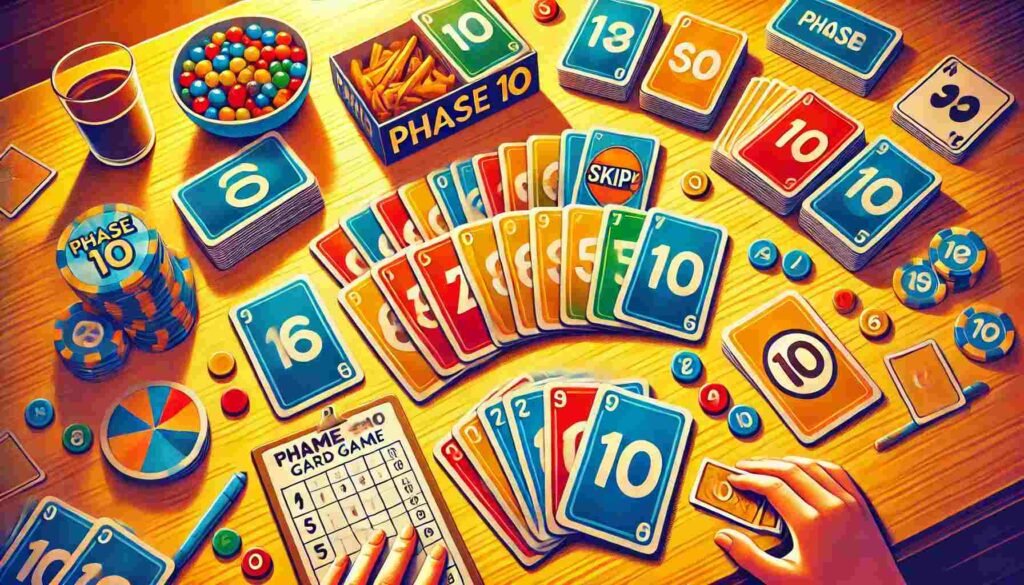
Detailed Phase 10 Rules
Understanding the 10 Phases
Phase 10 keeps gameplay exciting by requiring players to complete ten unique card combinations, each known as a “phase.” Here’s a quick rundown of the phases:
- Two sets of three
- One set of three + one run of four
- One set of four + one run of four
- One run of seven
- One run of eight
- One run of nine
- Two sets of four
- Seven cards of one color
- One set of five + one set of two
- One set of five + one set of three
Phase Rules
Phases must be completed in strict sequence, from Phase 1 through Phase 10. Here’s how it works:
- Sequential Order: Phases must be completed one by one, in order—no skipping ahead.
- All Cards in Hand: A phase can only be laid down when all required cards are in hand.
- Extra Cards Allowed: Players may add extra cards that fit a phase. For example, if a phase needs a set of three but the player has four of that card, all four can be laid down.
- One Phase per Round: Only one phase can be completed per round, even if the cards meet additional phase requirements.
- Phase Credit: Players receive credit for any phase they lay down, even if they don’t win the round. Multiple players may complete the same phase in a single round.
How to Progress Through Phases
Once a player completes a phase and lays it down, they move on to the next phase in the following round. If they fail to complete their phase, they must try again in the next round, which often results in players working on different phases simultaneously.
- Phase Progression: Each player progresses individually, advancing only when they successfully complete a phase in a hand.
- Same-Color Rule for Runs: In phases requiring a run (like a sequence of numbers), it’s often required that all cards in the run be of the same color.
Hitting Rules
Once a player has laid down their own phase, they can get rid of additional cards through hitting. Hitting allows players to place extra cards onto any laid-down phase, including those of other players, as long as the cards align with the existing combination.
- Timing: Players can only hit on their own turn and only after their phase is complete.
- Multiple Hits: A player may hit multiple cards in a single turn, as long as they match existing phases.
- Wild Card Rule: Standard rules do not allow players to replace a wild card in a phase with a matching number card, though some house rules may permit this.
Wild and Skip Cards Rules
The deck includes Wild cards and Skip cards, which add strategic twists:
- Wild Cards: These cards can replace any number or color, helping players complete challenging phases. Once used as a certain value, they stay that way for the round.
- Skip Cards: Play a Skip card to make an opponent miss their turn. This can disrupt their progress and is especially helpful if they’re close to completing a phase.
Finishing a Hand
After completing their phase, players aim to “go out” by getting rid of all their cards, either by discarding or hitting on existing phases.
- Going Out: Once a player completes their phase, they try to get rid of all their remaining cards as quickly as possible.
- Advancement: Players who go out and complete their phase move on to the next phase in the next round. Any players who didn’t complete their phase must attempt it again in the following hand.
Scoring Rules
At the end of each hand, players count up the value of leftover cards, with points assigned as follows:
- Cards 1-9: 5 points each
- Cards 10-12: 10 points each
- Skip Cards: 15 points each
- Wild Cards: 25 points each
The points are added to each player’s running total. Players who don’t complete their phase score a minimum of 50 points, often more due to high-value cards and Wilds (a situation known as being “set”).
After scoring, the dealer rotates, cards are shuffled, and a new hand begins. Players who completed their phase move forward, while those who did not repeat the same phase.
Winning the Game
Victory in Phase 10 requires both completing phases and managing your score:
- Completion of Phases: The game ends when one player completes all ten phases.
- Scoring Tie: If multiple players finish Phase 10 in the same round, the player with the lowest score wins.
Strategies for Phase 10 Success
- Efficient Phase Completion: Keep versatile cards (like Wilds) for flexibility, and plan for upcoming phases to complete them faster.
- Smart Wild & Skip Usage: Save Wilds for tough phases, and use Skip cards to block opponents nearing phase completion.
- Score Management: Discard high-value cards as rounds end to avoid costly points if another player goes out.
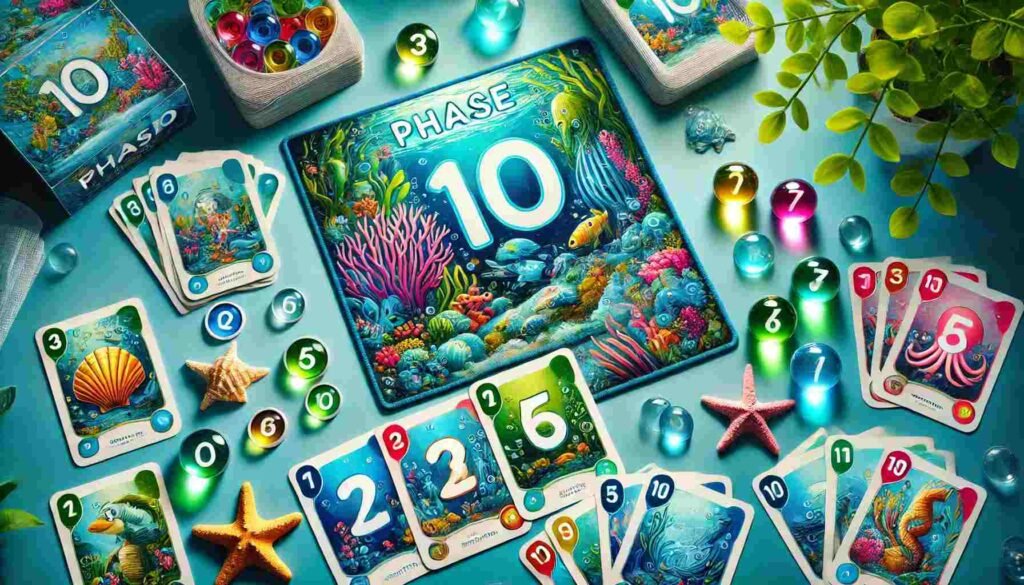
6 Exciting Variations for Phase 10
Phase 10 has inspired numerous variations over the years, each adding unique twists to the classic gameplay (as detailed on Wikipedia). These variations offer fresh challenges and themes, from alternative phase requirements to special rules for added strategy. If you’re a fan of the original but want to try something new, here are 6 Fun variants to mix up your card game nights.
1. Phase 10 Underwater Adventure
- Theme: Dive deep with phases inspired by sea creatures and the wonderland of the ocean.
- Phases:
- 1 set of 2 + 1 run of 4
- 1 run of 7 (same color as “coral”)
- 2 sets of 3
- 1 run of 5 + 1 set of 2
- 6 cards of one color (“deep blue” or “seaweed green”)
- 1 run of 6 (even numbers as “fish schools”)
- 1 set of 5 + 1 set of 3
- 4 cards of the same color + 2 sets of 2
- 7 odd-numbered cards
- 1 color run of 8
- Special Rule: The Deep Dive – Any time a player lays down a full phase, all other players must discard one card and draw a new one from the draw pile (simulating diving deeper into the deck).
2. Phase 10 Enchanted Forest
- Theme: Explore the mystical forest with phases based on mythical creatures and magical items.
- Phases:
- 1 set of 2 (as “fairies”) + 1 set of 4
- 1 run of 5 + 1 set of 3
- 3 sets of 2 (same color as “mushrooms”)
- 1 color run of 4
- 7 cards of one color (“green” as the “forest”)
- 1 set of 5 + 1 set of 3
- 1 run of 7 (odd numbers as “tree roots”)
- 1 set of 4 + 1 run of 4
- 6 even cards (“magical stones”)
- 2 color sets of 3 + 1 run of 5
- Special Rule: The Spellbound Card – When someone uses a Wild card, they must choose another player who cannot use any Wilds in their next phase.
3. Phase 10 Outer Space Odyssey
- Theme: Embark on a space mission, encountering planets, stars, and alien life.
- Phases:
- 1 run of 6
- 1 set of 4 + 1 set of 2 (same color for “asteroids”)
- 1 color run of 5
- 1 set of 3 + 1 run of 5
- 1 run of 8 (even numbers for “galaxies”)
- 1 color run of 7
- 3 sets of 3
- 5 cards of one color (“moon rocks”)
- 1 set of 5 + 1 run of 4
- 8 even-numbered cards (“alien life forms”)
- Special Rule: Zero Gravity – If a player completes a phase on their turn, they may choose any player to skip their next turn, simulating zero-gravity interference.
4. Phase 10 Safari Expedition
- Theme: Set out on a wild safari adventure with phases named after exotic animals and landscapes.
- Phases:
- 2 sets of 2 + 1 set of 3 (“lions, tigers, and bears”)
- 1 run of 5
- 1 run of 4 + 1 set of 2 (odd numbers for “elephants”)
- 6 cards of one color (“savanna”)
- 2 color sets of 3
- 1 color run of 6
- 1 run of 7 (same color as “sunset”)
- 1 set of 4 + 1 run of 5
- 1 set of 3 + 1 run of 6
- 9 even-numbered cards
- Special Rule: The Wild Animal Card – When using a Wild card, players must announce an animal sound (e.g., roar, growl, chirp). Failing to do so results in drawing an extra card.
5. Phase 10 Volcano Island
- Theme: Escape an erupting volcano, racing through phases named after lava, ash, and tropical surroundings.
- Phases:
- 1 set of 3 (same color as “lava”) + 1 run of 4
- 8 cards of one color (“island flora”)
- 1 run of 7
- 2 sets of 3
- 1 set of 4 + 1 run of 5
- 1 run of 6 + 1 set of 3
- 1 color run of 5
- 3 sets of 2
- 1 run of 4 + 1 set of 4
- 7 odd-numbered cards
- Special Rule: Eruption Warning – Any time a player completes a phase, the next player must draw an additional card to “dodge lava.”
6. Phase 10 Haunted Mansion
- Theme: Uncover the spooky mysteries of a haunted mansion with ghostly phases and eerie rules.
- Phases:
- 1 set of 3 + 1 set of 2
- 1 run of 5
- 6 even cards (as “ghosts”)
- 1 color run of 4
- 1 set of 5
- 1 run of 6 + 1 set of 2
- 7 cards of one color (“haunted rooms”)
- 3 sets of 3
- 1 set of 4 + 1 run of 5
- 1 color run of 6
- Special Rule: The Phantom Draw – At the end of each turn, players must draw an extra card unless they have completed their phase, adding suspense and tension to each move.
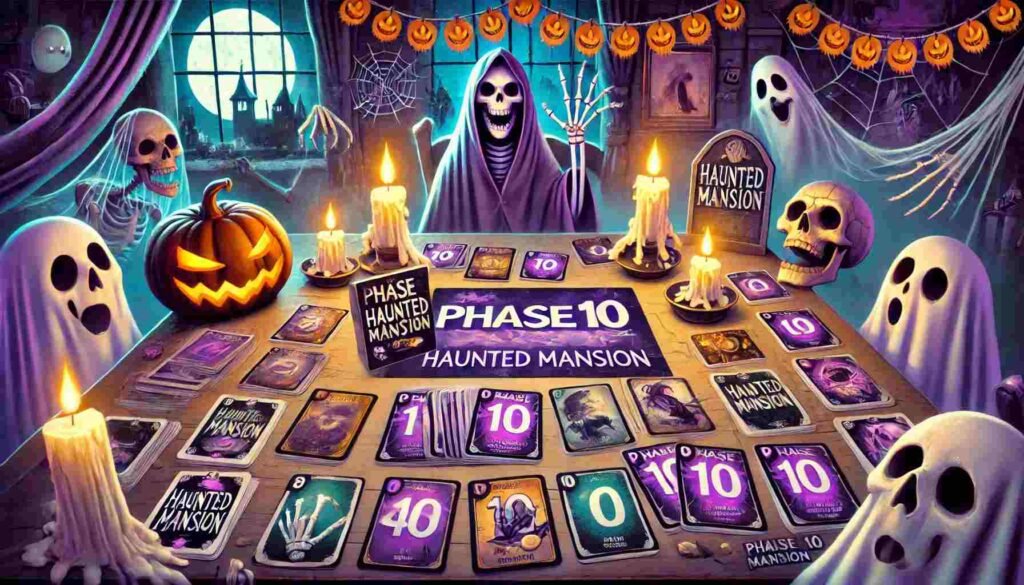
Drunk Phase 10: Turn Card Game to Party Fun
Drunk Phase 10 is an exciting twist on the classic Phase 10 card game, perfect for adults looking to combine gameplay with a fun social drinking experience (Plus, if you want to know how to turn UNO into a drinking game, hover over How to Play Drunk UNO).
Setting Up Drunk Phase 10
To set up a successful Drunk Phase 10 game night, you’ll need:
- Phase 10 Card Deck: The classic deck is essential for gameplay.
- Shot Glasses: At least one per player; optional extras for custom rules.
- Your Choice of Drinks: Ensure drinks are on hand, whether they’re alcoholic or non-alcoholic.
- Custom Rule Card: Many pre-made sets include a laminated instruction card with suggested rules for adding drinks to the game.
Drinking Rules for Drunk Phase 10
In Drunk Phase 10, the goal is to add fun and lighthearted challenges. Here are some creative rule variations:
- Phase Fail Shot: If you fail to complete a phase, take a shot.
- Skip Sip: Playing a Skip card lets you assign a sip to any player of your choice.
- Phase Completion Cheers: When someone completes a phase, all players take a sip in celebration.
- Wild Card Wipeout: Using a Wild card means everyone takes a sip—after all, things are about to get unpredictable!
Adding Personalized House Rules
House rules are an easy way to make the game unique. Try these customizable ideas:
- Silent Rounds: Choose a phase where no one can talk while playing. Anyone who slips up takes a drink!
- Secret Words: At the start of the round, pick a “secret word.” Anytime someone says it, they drink.
- Group Challenges: Decide that all players must hold up their cards dramatically or cheer if anyone advances two phases in a row.
These fun and flexible rules keep everyone engaged and can be adapted based on players’ preferences.
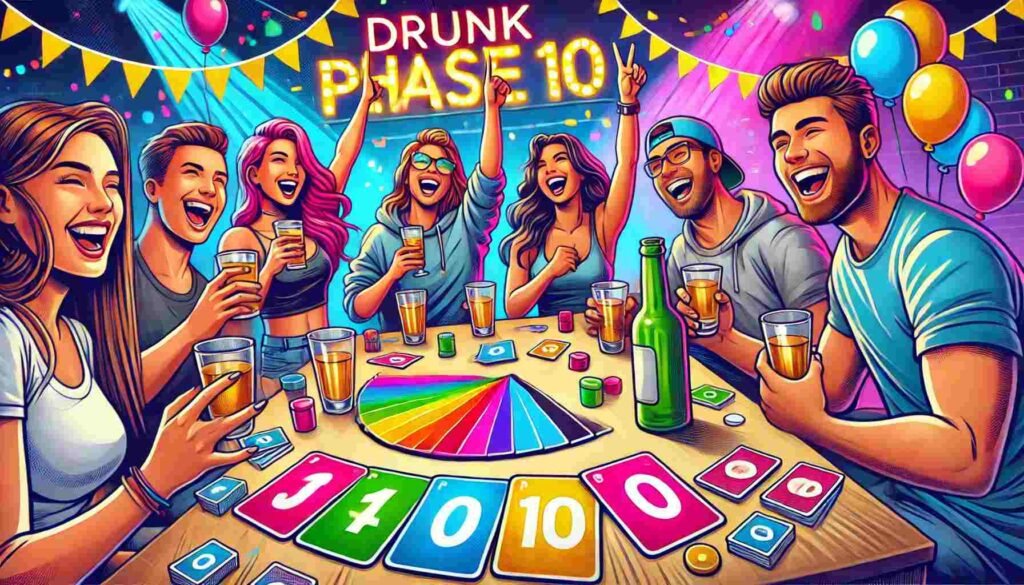
Popular Drunk Phase 10 Sets and Custom Kits
Custom “Drunk Phase 10” sets have become popular, with many available on Etsy and specialty sites. These sets typically include everything needed for a ready-made experience, including Phase 10 cards, shot glasses, and a rule card for adding drinks.
What’s Included in Each Set
- Phase 10 Card Deck: The game’s core component.
- Decorative Shot Glasses: Often themed, adding flair to the game.
- Laminated Drinking Rules Card: Provides easy-to-follow drinking variations for beginners or experienced players.
- Storage Box: For easy portability to game nights or parties.
These kits make it simple to set up and start playing, allowing groups to dive right into the fun without needing to brainstorm rules on the spot.
Tips for Safe and Enjoyable Gameplay
Responsible Drinking Guidelines
Drunk Phase 10 is all about having a good time, so setting a few ground rules ensures everyone enjoys the game responsibly:
- Set Limits: Encourage everyone to pace themselves and take breaks as needed.
- Water and Snacks: Keep water and snacks on hand to keep players hydrated and energized.
Alternative Play for Non-Drinkers
For non-drinkers or those who want an alcohol-free option, consider substituting drinking penalties with fun challenges:
- Funny Dares: If someone misses a phase, they could do a silly dance or sing a line from a song.
- Wear a Prop: Have a prop on hand (like a hat or glasses) that someone must wear if they lose a phase.
These options ensure everyone can participate and enjoy the game without pressure.
FAQ for Phase 10 Card Game
How do you play Phase 10 for beginners?
Beginners should focus on understanding the phases and learning how to use Wild and Skip cards strategically. Start by familiarizing yourself with each phase’s requirements and the turn structure.
Can Phase 10 be played with a regular deck?
While it’s possible to simulate Phase 10 with a regular deck, it won’t have Wild and Skip cards. You’ll need to adapt the rules to accommodate these limitations.
How do you win Phase 10 with 2 players?
If more than one player completes Phase 10, the game goes to a tiebreaker: the player with the lowest score wins.
Are there Phase 10 variations?
Yes, Phase 10 has many creative variations! Players often introduce new themes and challenges, like unique phase sequences, color-based rules, or special cards. Some popular versions include “Phase 10 Island Paradise” and “Disco Fever,” each with their own phase requirements and fun twists. You can even create your own custom rules to make the game more exciting and tailored to your group!
Is Phase 10 an adult game?
Phase 10 is designed for all ages, typically recommended for ages 7 and up. However, it can be easily modified for adults, especially with variations like “Drunk Phase 10,” where social drinking rules are added for a more mature game night experience.
What is the floating rule in Phase 10?
The floating rule is a house rule allowing players who complete their phase but don’t finish the round to “float,” or keep playing in subsequent rounds, rather than discarding their hand and waiting. This adds a fun, strategic twist, keeping players engaged in each phase.
Does color matter in Phase 10?
Yes, color matters in some phases, especially those requiring a “run” or specific color sets. For example, phases that call for a sequence of numbers might also require all cards in that run to be the same color.
How do you play Phase 10 Flip?
Phase 10 Flip is a variation where a double-sided deck is used, featuring both a “Light” and a “Dark” side, each with different challenges. Players flip between sides, completing phases according to the side in play, adding complexity and variety to the classic game.
Is Phase 10 like UNO?
Phase 10 and UNO share similarities—they’re both card games with sequential play and special cards. However, Phase 10 is more strategy-based, requiring players to complete specific phases, whereas UNO is simpler and faster-paced with a focus on matching colors or numbers.
How long does Phase 10 take to play?
A standard game of Phase 10 typically takes 1 to 2 hours, depending on the number of players and how quickly they complete each phase.
Are there games similar to Phase 10 and UNO?
These games bring variety and strategy, perfect for fans of Phase 10 and UNO looking for new challenges:
1. Skip-Bo: A sequential card game where players build piles to empty their stockpile first, similar to Uno’s card-drawing but focused on sequences.
2. Crazy Eights: Players discard by matching suit or rank, with eights acting as wild cards, like Uno’s special cards.
3. Fluxx: A constantly changing game where rules shift based on drawn cards, creating unpredictable gameplay.
4. Five Crowns: Rummy-style, with players forming sets and runs over 11 rounds; great for Phase 10 fans.
5. Red 7: Players aim to win each round by following changing rules, with a mix of color and number matching.
6. Taco Cat Goat Cheese Pizza: Fast-paced matching and slapping game, ideal for family gatherings.
7. Monopoly Deal: A quick card-based version of Monopoly where players collect property sets and use action cards.
8. Hanabi: A cooperative game requiring players to give hints and play cards in sequence, emphasizing teamwork.
Can you play UNO with Phase 10 cards?
No, you cannot play UNO with Phase 10 cards because they lack essential UNO action cards like “Draw Two,” “Reverse,” and “Wild Draw Four,” which are central to UNO gameplay. However, you can use an UNO deck to play Phase 10 by assigning UNO’s colors and numbers to represent the phases. This way, UNO’s flexibility allows it to mimic the structure of Phase 10, while the reverse isn’t possible.
